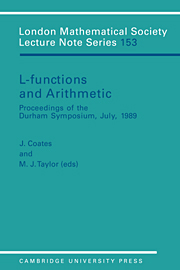Book contents
- Frontmatter
- Contents
- Preface
- Participants
- Lectures on automorphic L-functions
- Gauss sums and local constants for GL(N)
- L-functions and Galois modules
- Motivic p-adic L-functions
- The Beilinson conjectures
- Iwasawa theory for motives
- Kolyvagin's work for modular elliptic curves
- Index theory, potential theory, and the Riemann hypothesis
- Katz p-adic L-functions, congruence modules and deformation of Galois representations
- Kolyvagin's work on Shafarevich-Tate groups
- Arithmetic of diagonal quartic surfaces I
- On certain Artin L-Series
- The one-variable main conjecture for elliptic curves with complex multiplication
- Remarks on special values of L-functions
The Beilinson conjectures
Published online by Cambridge University Press: 18 December 2009
- Frontmatter
- Contents
- Preface
- Participants
- Lectures on automorphic L-functions
- Gauss sums and local constants for GL(N)
- L-functions and Galois modules
- Motivic p-adic L-functions
- The Beilinson conjectures
- Iwasawa theory for motives
- Kolyvagin's work for modular elliptic curves
- Index theory, potential theory, and the Riemann hypothesis
- Katz p-adic L-functions, congruence modules and deformation of Galois representations
- Kolyvagin's work on Shafarevich-Tate groups
- Arithmetic of diagonal quartic surfaces I
- On certain Artin L-Series
- The one-variable main conjecture for elliptic curves with complex multiplication
- Remarks on special values of L-functions
Summary
Introduction
The Beilinson conjectures describe the leading coefficients of L-series of varieties over number fields up to rational factors in terms of generalized regulators. We begin with a short but almost selfcontained introduction to this circle of ideas. This is possible by using Bloch's description of Beilinson's motivic cohomology and regulator map in terms of higher Chow groups and generalized cycle maps. Here we follow [Bl3] rather closely. We will then sketch how much of the known evidence in favour of these conjectures — to the left of the central point — can be obtained in a uniform way. The basic construction is Beilinson's Eisenstein symbol which will be explained in some detail. Finally in an appendix a map is constructed from higher Chow theory to a suitable Ext-group in the category of mixed motives as defined by Deligne and Jannsen. This smooths the way towards an interpretation of Beilinson's conjectures in terms of a Deligne conjecture for critical mixed motives [Sc2]. It also explains how work of Harder [Ha2] and Anderson fits into the picture.
For further preliminary reading on the Beilinson conjectures, one should consult the Bourbaki seminar of Soulé [Sol], the survey article by Ramakrishnan [Ra2] and the introductory article by Schneider [Sch]. For the full story see the book [RSS] and of course Beilinson's original paper [Bel]. Here one will also find the conjectures for the central and near-central points, which for brevity we have omitted here.
- Type
- Chapter
- Information
- L-Functions and Arithmetic , pp. 173 - 210Publisher: Cambridge University PressPrint publication year: 1991
- 16
- Cited by

